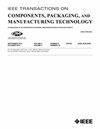Finite-Element Analysis and Multiobjective Optimization of Solder Joint Temperature Difference and Cooling Stress During PCBA Reflow Process
IF 2.3
3区 工程技术
Q2 ENGINEERING, ELECTRICAL & ELECTRONIC
IEEE Transactions on Components, Packaging and Manufacturing Technology
Pub Date : 2025-01-14
DOI:10.1109/TCPMT.2025.3529292
引用次数: 0
Abstract
A finite-element analysis model of a printed circuit board assembly (PCBA) was established. The model was subjected to a reflow soldering temperature profile to analyze the temperature distribution at the solder joint solidification moment and the cooling stress distribution at the end of the reflow soldering process. Validation experiments confirmed the accuracy of the simulation results. The response surface methodology (RSM) combined with the NSGA-II algorithm was employed to optimize the reflow soldering process parameters with the dual objectives of minimizing solder joint temperature difference and cooling stress. The results reveal uneven temperature distribution at the solder joint solidification onset and concentrated cooling stress due to the mismatch in thermal expansion coefficients. The optimized reflow soldering process parameters were determined as: soak time of 80 s, reflow time of 35 s, reflow temperature ofPCBA 回流焊过程中焊点温差和冷却应力的有限元分析与多目标优化
本文章由计算机程序翻译,如有差异,请以英文原文为准。
求助全文
约1分钟内获得全文
求助全文
来源期刊

IEEE Transactions on Components, Packaging and Manufacturing Technology
ENGINEERING, MANUFACTURING-ENGINEERING, ELECTRICAL & ELECTRONIC
CiteScore
4.70
自引率
13.60%
发文量
203
审稿时长
3 months
期刊介绍:
IEEE Transactions on Components, Packaging, and Manufacturing Technology publishes research and application articles on modeling, design, building blocks, technical infrastructure, and analysis underpinning electronic, photonic and MEMS packaging, in addition to new developments in passive components, electrical contacts and connectors, thermal management, and device reliability; as well as the manufacture of electronics parts and assemblies, with broad coverage of design, factory modeling, assembly methods, quality, product robustness, and design-for-environment.
 求助内容:
求助内容: 应助结果提醒方式:
应助结果提醒方式:


